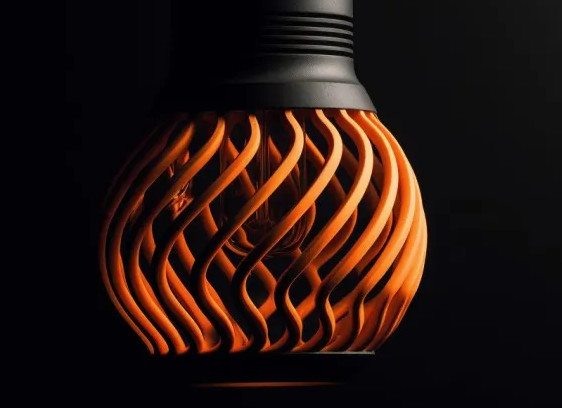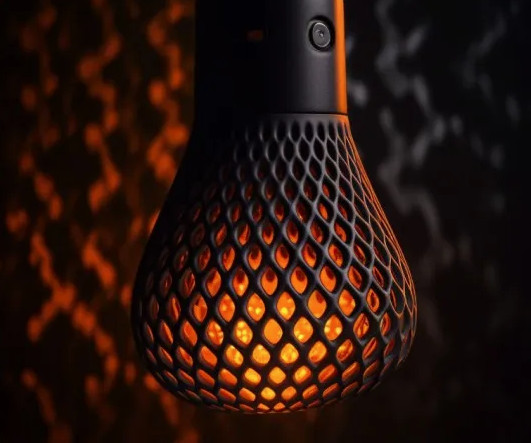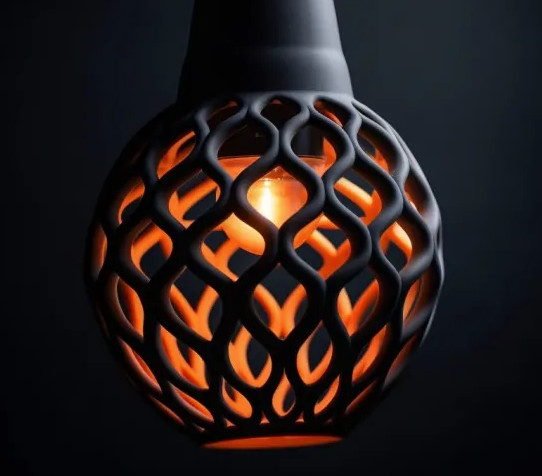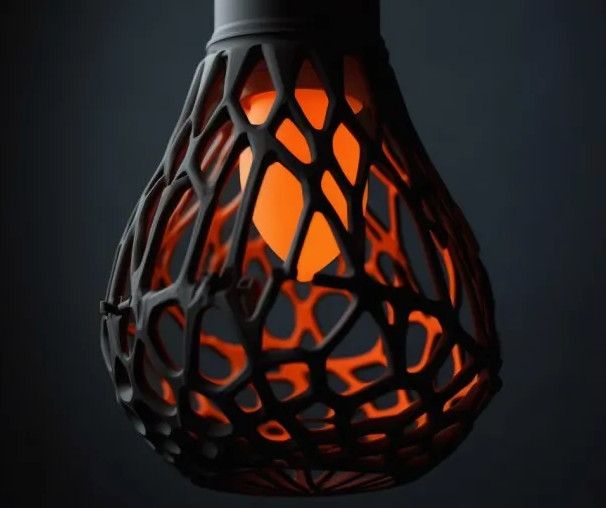Key Advantages of 3D Printing for Lighting
3D printing revolutionizes lighting design by offering unique capabilities that traditional manufacturing cannot match. Below are the primary advantages of using 3D printing for lighting fixtures.
Complex Geometries
3D printing enables the creation of intricate designs that are challenging or impossible with conventional methods. Designers can produce hollow structures, organic forms, or fractal patterns such as biomimetic textures and lattice designs. These geometries enhance both aesthetic appeal and functional light distribution, allowing for innovative lighting solutions tailored to specific environments.
Customization
With 3D printing, lighting fixtures can be tailored to precise space dimensions, user preferences, or brand identities. Designers can embed logos, personalized patterns, or unique shapes directly into the fixture, ensuring a bespoke product that aligns with client needs or project requirements.
Rapid Prototyping and Iteration
3D printing allows for quick production of prototypes to test light effects, proportions, and functionality. This rapid iteration process reduces development time and costs, enabling designers to refine innovative lighting designs efficiently before final production.
Lightweight and Optimized Structures
Using techniques like topology optimization, 3D printing minimizes material usage while maintaining structural integrity. This results in lightweight lighting fixtures that reduce installation complexity and material costs without compromising durability.

Key Directions in 3D Printed Lighting Design
3D printing opens new possibilities for lighting design, focusing on functionality, integration, and aesthetic innovation. The following directions highlight how designers can leverage this technology.
Artistic Sculptural Lighting
3D printing enables the creation of lighting fixtures that serve as sculptural art pieces. Designers can craft biomimetic designs inspired by natural forms like leaf veins or coral structures, as well as abstract geometric stacks or dynamic suspended fixtures. Tools like Rhino with Grasshopper facilitate parametric modeling, while high-precision SLA or DLP printing with photosensitive resin ensures detailed, high-quality outputs.
Smart and Functional Lighting
3D printed fixtures can integrate advanced technologies such as LED strips, wireless charging modules, or smart sensors for features like human body induction dimming. To ensure safety and performance, designers should use high-temperature-resistant materials like nylon (PA) or flame-retardant PLA, which withstand the heat generated by embedded electronics.
Interactive Light and Shadow Experiences
3D printing allows designers to manipulate light diffusion and projection through material and structural choices. Translucent materials like PETG or clear resin, combined with varied layer thicknesses, control light dispersion. Hollow outer shells can project custom patterns, such as starry skies or city silhouettes, onto surfaces, creating immersive lighting effects.

Technical Considerations for 3D Printed Lighting
Successful 3D printed lighting requires careful attention to technical details to ensure functionality, durability, and aesthetic quality. Below are the critical considerations.
Structural Optimization
Topology optimization software, such as nTopology, enables designers to minimize material usage while ensuring the strength of load-bearing components. Hollow designs with internal supports reduce weight and material costs, making fixtures easier to install and more cost-effective.
Controlling Light Translucency
Light transmission can be fine-tuned by adjusting print layer thickness (0.1-0.3mm) and infill density (10-30%). Post-processing techniques, such as sandblasting or chemical polishing, enhance uniform light scattering in translucent materials, improving the visual quality of the lighting effect.
Effective Heat Management
High-power LEDs require robust heat dissipation to ensure longevity. Designers can incorporate honeycomb cooling holes or embed metal heat sinks within the printed structure. Avoiding fully enclosed designs and leveraging the chimney effect promotes airflow, preventing overheating and extending LED lifespan.
Assembly and Finishing
Modular designs allow parts to be printed separately and assembled using snaps or screws, simplifying transport and maintenance. Surface treatments like electroplating, matte spray painting, or hand-painted gold leaf enhance aesthetic and tactile quality, elevating the fixture’s perceived value.

Material and Printing Technology Comparison
Choosing the right materials and printing technologies is critical for 3D printed lighting. The table below compares common options.
| Material | Printing Technology | Key Properties | Best Use Case |
|---|---|---|---|
| Photosensitive Resin | SLA/DLP | High precision, smooth finish, translucent options | Artistic fixtures, intricate designs |
| Nylon (PA) | SLS | High-temperature resistance, durable | Smart lighting with embedded electronics |
| PETG | FDM | Translucent, cost-effective, durable | Light diffusion, budget-conscious designs |
| Flame-Retardant PLA | FDM | Fire-resistant, easy to print | Functional lighting with safety requirements |
Conclusion
3D printing offers unparalleled flexibility in lighting design, enabling complex geometries, customization, and rapid prototyping. By addressing technical considerations like structural optimization, light translucency, heat management, and assembly, designers can create functional and visually striking fixtures. With the right materials and printing technologies, 3D printed lighting balances aesthetics, engineering, and user needs, delivering high-end solutions for diverse applications.
FAQ: 3D Printing for Lighting Fixtures
What makes 3D printing better than traditional manufacturing for lighting fixtures?
3D printing offers unique advantages that traditional methods (like injection molding or machining) can’t match, including:
The ability to create complex, intricate geometries (e.g., lattice structures, organic forms) that enhance light distribution and aesthetics.
High customization (e.g., embedding logos, tailoring sizes to specific spaces).
Rapid prototyping, which speeds up design iteration and reduces development costs.
Lightweight, material-efficient structures that lower installation and production costs.
Can 3D printed lighting be mass-produced, or is it only for prototypes?
While 3D printing is widely used for rapid prototyping, it can also scale to production, especially for:
Custom or low-volume runs (e.g., bespoke fixtures for luxury spaces).
Complex designs that are too costly to mass-produce with traditional methods.
Modular designs (printed in parts and assembled later), which simplify manufacturing and transport.
Is 3D printed lighting more expensive than traditional options?
Cost varies:
Prototyping/ low-volume custom designs: 3D printing is often cheaper (avoids expensive molds for traditional methods).
High-volume production: Traditional methods may be more cost-effective for simple, standardized designs.
Complex geometries: 3D printing is cost-competitive here, as traditional methods struggle with intricate shapes.
